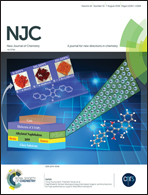Catalytic activity of corrole complexes with post-transition elements for the oxidation of carbon monoxide: a first-principles study†
Abstract
This theoretical investigation explores the electronic and catalytic properties for the complexes of 5,10,15-tris-phenyl corrole with several post-transition elements, namely, CorM with M = Al, Ga, Si, Ge and As. Aiming to gain insight into the catalytic activity of corrole complexes, we investigate the mechanistic details for the catalytic oxidation of CO over the considered corrole complexes. It is found that except for CorAs, the other considered CorM can efficiently activate the adsorbed O2 molecule. In the case of CorSi and CorGe, the formation of a stable carbonate-like intermediate does not allow the CO oxidation to proceed. In contrast, CorAl and CorGa are able to facilitate the activation of O2 and subsequently promote the oxidation of CO. We show that the calculated barriers for the CO oxidation mediated by CorAl and CorGa are comparable with those previously obtained for other metal–carbon surfaces such as iron- and copper-embedded graphene. However, the synthesis feasibility of CorAl and CorGa shows promise towards designing non-noble metal catalysts for low-temperature CO oxidation with higher activity and lower cost.



 Please wait while we load your content...
Please wait while we load your content...